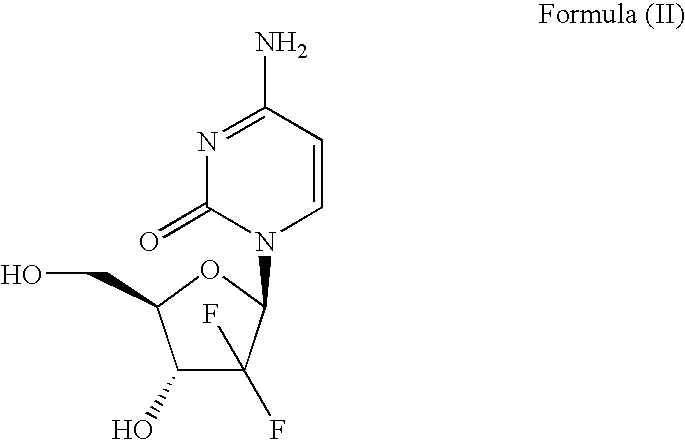Process for Preparation of Gemcitabine Hydrochloride
a technology of gemcitabine and hydrochloride, which is applied in the field of new products, can solve the problems of cell death and interference with growth, and achieve the effect of high yield and high purity
- Summary
- Abstract
- Description
- Claims
- Application Information
AI Technical Summary
Benefits of technology
Problems solved by technology
Method used
Image
Examples
example 1
Preparation of 2-deoxy-D-erythro-2,2-difluoro-ribofuranose-3,5-dibenzoate
[0031]2-deoxy-D-erythro-2,2-difluoro-pentafuranos-1-ulose-3,5-dibenzoate (200 g) was dissolved in (2 L) of tetrahydrofuran in a 5 L round bottom flask. (0.2 L) of vitride (70% solution in toluene) was added between −50 to −70° C. The reaction was continued for 60 minutes. On completion, reaction was arrested by adding methanol (0.24 L) followed by hydrolysis with 7% HCl (1.3 L). After stirring for ˜30 min the aqueous layer was separated at RT. The aqueous layer was repeatedly extracted with Ethyl acetate (0.8 L×2). The collected organic layer was washed with brine (0.5 L×2) and 5% aqueous NaHCO3 (0.5 L×2) followed by brine (0. 5 L×2). The organic layer was concentrated under vacuum to get thick oil (0. 2 kg).
example 2
Preparation of 2-deoxy-D-erythro-2,2-difluoro-ribofuranose-3,5-dibenzoate-1-methanesulfonate
[0032]2-deoxy-D-erythro-2,2-difluoro-ribofuranose-3,5-dibenzoate (0.2 kg) oil was dissolved in (2 L) Methylenedichloride. The reaction mixture was cooled to 0 to −20° C. and (0.12 L) triethylamine was added. To this stirred mixture was added (0. 06 L) Methane sulfonylchloride drop wise between −20° C. to −15° C. The reaction was stirred at same temperature till completion of reaction (in ˜3 hours). Temperature was brought to room temperature & 5% HCl (0.9 L) was added to reaction. The aqueous layer was separated and extracted with Methylene dichloride (0.4 L×2). The organic layer was washed with brine (0.5 L×2) & by 5% aqueous sodium bicarbonate followed by brine (0.5 L×2). The organic layer was collected and concentrated to give oil (0.24 kg).
example 3
Preparation of Gemcitabine Base
[0033]Acetyl cytosine (200 g) was added to 1,2-dichloroethane (4 L) in 10 L round bottom flask. Hexamethyldisilazane (0.34 L) was added to the slurry. The resulting mixture was heated to distill out ˜1 L mixture. The reaction mass cooled to 50° C. under nitrogen and trimethyl silyl chloride (0.015 L) was added to the mixture. The resulting mixture was refluxed at 82-85° C. for 3 hours. The solution was cooled to 45° C. under nitrogen and distilled at 45-50° C. to obtain solid. Fresh ethylene dichloride (2.6 L) was added to the solid so obtained followed by addition of Trimethyl silyl triflate (0.26 L). To this solution of mesylate (0.24 L) obtained from example no 2 dissolved in ethylene dichloride (1.2 L) was added. The resulting mixture was heated to reflux at 86-92° C. for 18 hours till 2-deoxy-2,2-difluoro-ribofuranose-3,5-dibenzoate-1-methnesulfonate was consumed. The reaction mixture was cooled at room temperature and 5% HCl (1.8 L) was added to ...
PUM
| Property | Measurement | Unit |
|---|---|---|
| Temperature | aaaaa | aaaaa |
| Temperature | aaaaa | aaaaa |
| Temperature | aaaaa | aaaaa |
Abstract
Description
Claims
Application Information
 Login to View More
Login to View More - R&D
- Intellectual Property
- Life Sciences
- Materials
- Tech Scout
- Unparalleled Data Quality
- Higher Quality Content
- 60% Fewer Hallucinations
Browse by: Latest US Patents, China's latest patents, Technical Efficacy Thesaurus, Application Domain, Technology Topic, Popular Technical Reports.
© 2025 PatSnap. All rights reserved.Legal|Privacy policy|Modern Slavery Act Transparency Statement|Sitemap|About US| Contact US: help@patsnap.com



